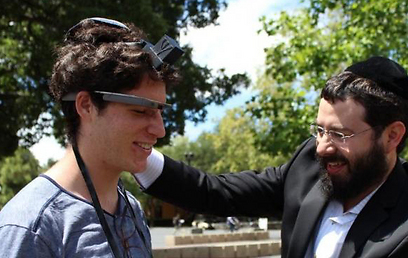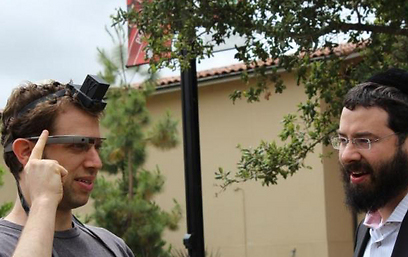“As I watched students wrap tefillin at Stanford, it became clear to me that those who carry with them the heritage of the past are those who can face the future without fear," Rabbi Greenberg told the Chabad website.

Rabbi Greenberg with one of Stanford students (photo courtesy of Chabad website COL)
One of the university students wrote on his blog that Rabbi Greenberg had told him, "Many Jewish students who had never wrapped tefillin before came out to do so. Some of them told me it was their first time wearing Google Glass and tefillin."
"I am not sure exactly how this Chabad rabbi was able to get his hands on Google Glass," the student wondered. "I assume being on campus at Stanford helped. I also believe someone let him borrow it for this purpose or maybe it was donated."

How did rabbi get his hands on glasses? (Photo courtesy of Chabad website COL)
The Google glasses contain a small screen, a cellular phone, a GPS antenna, a microphone and earphones, and they can interpret voice commands, record videos and pictures and communicate with other devices.
The Google Glass is not available to the public yet. In March, the search engine giant selected 8,000 people who got the opportunity to purchase the computer eyewear for $1,500. The candidates were asked to submit an application explaining how they would use the new technology.
According to the Wired website, the company barred the experimenters from selling or even loaning out the highly coveted gadget.
"If you resell, loan, transfer, or give your device to any other person without Google’s authorization, Google reserves the right to deactivate the device, and neither you nor the unauthorized person using the device will be entitled to any refund, product support, or product warranty,” the company’s terms of service state.















